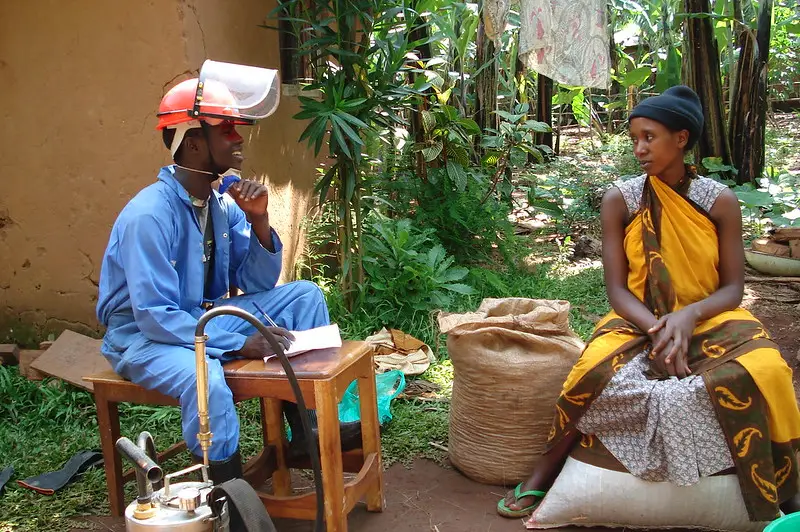
Photo by Louise Gubb for RTI International
Climate change is producing the perfect storm for a surge of mosquito abundance and the deadly diseases they carry. Warming global temperatures and changing rainfall patterns are creating an increase in suitable breeding conditions for mosquitoes, allowing their numbers to rise and their geographic range to expand. As a result, we are now seeing a re-emergence of malaria in countries that once had it under control and new cases of other mosquito-borne diseases, such as dengue and chikungunya, in regions where they’ve never been previously reported.
This is no small matter.
As we mark World Malaria Day, it’s timely to note that mosquitoes are vectors for diseases that already kill more than one million people annually, infect another 700 million, and amount to an economic cost of US $12 billion per year.
As mosquito populations expand, many more people will be at risk—a risk that is exacerbated when health care practitioners lack the tools and training to diagnose and manage vector-borne diseases that are new to, or re-emerging in, their communities.
As an epidemiologist and veterinarian who has spent decades studying vector-borne diseases in humans and animals, it’s clear to me that we can no longer remain in our usual academic and subject-matter-specific silos.
How climate change is affecting mosquito-borne disease spread
Warmer temperatures can extend the period that mosquitoes are abundant, particularly in places where mosquitoes are not active year-round. This can result in small outbreaks of disease, as witnessed in France and Italy, where outbreaks of dengue were reported last year. Although dengue is non-endemic in Europe, recent mathematical models suggest dengue could be endemic in the United Kingdom by 2050 and in southern Europe within 15 to 20 years.
Increased rainfall is especially conducive to the proliferation of mosquitoes. In 2019 in Zanzibar, for example, due to an anomalous increase of precipitation, malaria transmission rates were higher in the “short” rainy season compared to the usual increase in cases recorded during the “long” rainy season. Variation of the rainfall pattern has been recorded across the eastern coast of Africa with an important impact on malaria transmissions in Tanzania, Kenya, and Ethiopia, among others.
In addition to creating favorable breeding conditions for mosquitoes, research suggests that climate change could accelerate the incubation of pathogens in mosquitoes, as well as the insects’ overall development and biting rates, exacerbating the potential for mosquito and disease spread (read more here and here).
Warmer, wetter conditions also support the expansion of the pathogens—typically a protozoa or virus—that cause infection and illness. Various species of mosquitoes that weren’t previously carriers can become vectors when a new agent is introduced into their habitat.
Similarly, mosquitoes themselves are also on the move. Anopheles stephensi, a mosquito species and a primary malaria vector common in Asia, has recently taken a foothold in several countries in Africa . In contrast with the common African malaria vectors, this mosquito species can successfully breed in small water containers and other human-made water reservoirs that are ubiquitous in urban settings, with malaria outbreaks in urban areas caused by Anopheles stephensi reported in Djibouti, Ethiopia, and Sudan.
Health systems strengthening, innovation, and preparation are essential for malaria elimination
Even after the hard-earned lessons of the COVID-19 pandemic, health care systems globally are not prepared to address the growing threat of mosquito-borne disease in the context of climate change. Though readiness is preached, governments and the public often fail to heed the advice, leading to reactive rather than proactive responses.
While it was heartening to see the inclusion of a health day at the recent COP28 climate talks, significant funding is required to begin training health care workers, strengthen differential diagnosis, conduct public awareness campaigns, monitor the distribution and expansion of old and new mosquito vectors, and support the development of climate-informed surveillance to monitor outbreaks and variations occurring in vector-borne diseases.
Apart from genetically modified mosquitoes, which carry a self-limiting gene that prevents female offspring from maturing into adulthood, vector control methods haven’t expanded much beyond repellants, bed nets, and insecticides for indoor residual spraying of households. And while wealthier nations can afford to ramp up their response to vector-borne diseases, such as the West Nile virus across the US, the global health community must ensure that low and lower-middle income nations aren’t left behind and unable to protect their citizens.
Moving beyond silos to address how climate change impacts health
A coordinated, international effort is required to proactively address vector-borne diseases and other global health issues associated with climate change. As an epidemiologist and veterinarian who has spent decades studying vector-borne diseases in humans and animals, it’s clear to me that we can no longer remain in our usual academic and subject-matter-specific silos.
I’ve seen the value of RTI’s holistic, cross-sectoral approach in addressing complex, multi-faceted challenges driven by climate change, and a similar umbrella strategy is needed to deal with the multiple factors contributing to the proliferation of mosquitoes and the diseases they spread.
For instance, in addition to teams of epidemiologists and public health experts, other specialists such as biologists, agricultural specialists, engineers, urban planners, and communicators could provide valuable insight and expertise in response efforts.
Partnership and cross-collaboration across government agencies, such as the ministries of Health, Agriculture, Forestry, Fisheries, Environment, Economy, and Education should be prioritized, as well as public-private partnerships and locally led development.
Lastly, citizens should be empowered to be part of the solution. Campaigns to educate communities on eliminating sources of standing water around their homes, changing behavior, and urging people to seek prompt treatment when ill, can go a long way in preventing diseases from spreading.
Disease eradication is not a simple problem, and it has no simple solution. By working collaboratively and proactively across sectors, we can reduce the suffering, death, and economic losses wrought by mosquito-borne diseases.
Learn more about RTI’s work in malaria control and prevention, global health, and climate change.
